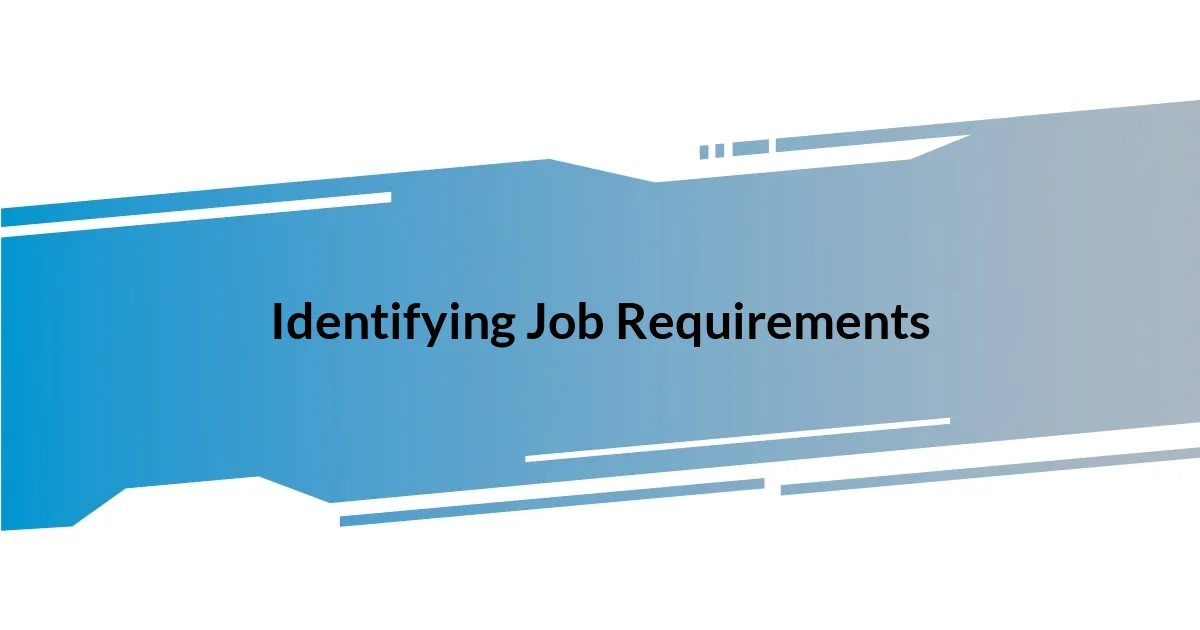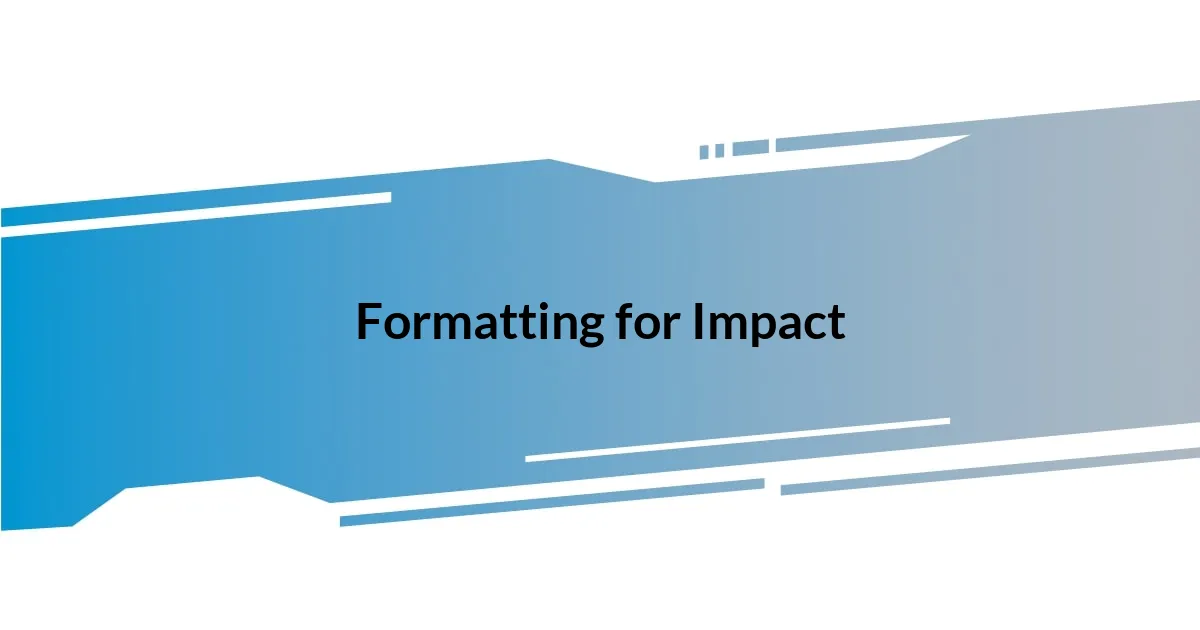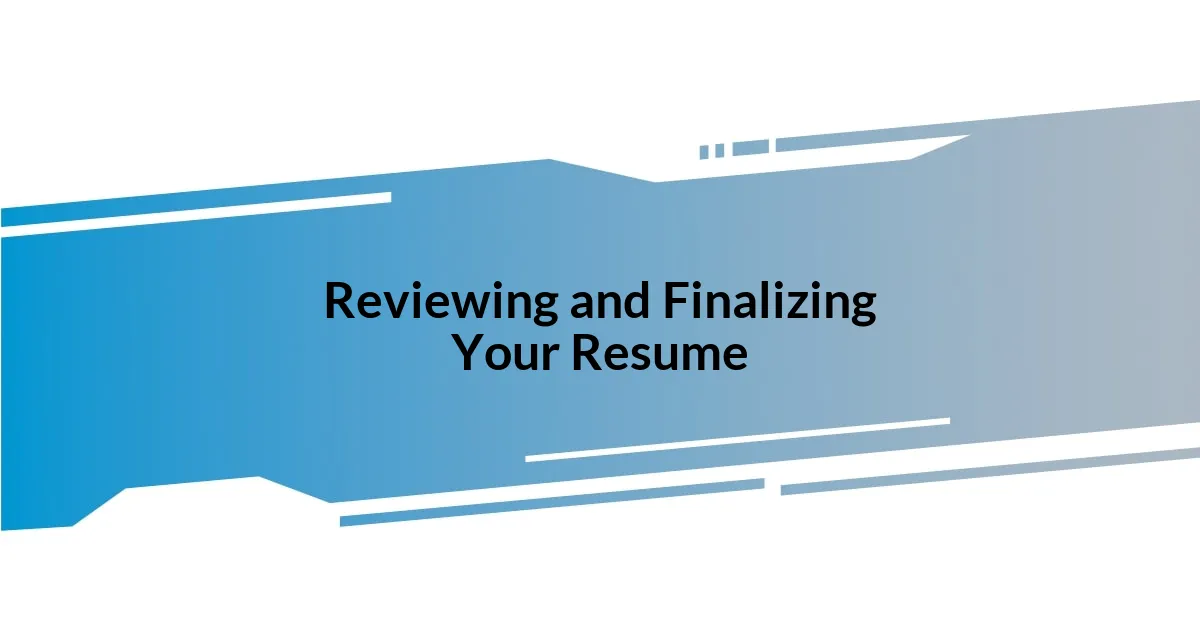Key takeaways:
- Customization of your resume involves aligning it with the specific job description, highlighting relevant skills, and using industry-specific keywords to attract employers’ attention.
- Your professional summary should reflect not only your skills but also your passion and unique value, telling a compelling story of your career journey.
- Formatting plays a crucial role; a clean design, easy-to-read fonts, and tailored headers can significantly enhance the impact of your resume.
- Thoroughly review and revise your resume for errors and flow, ensuring it conveys your enthusiasm and effectively showcases your qualifications.

Understanding Resume Customization
Understanding resume customization goes beyond simply tweaking a few phrases; it’s about tailoring your entire document to align with the specific role you’re pursuing. I remember when I applied for a marketing position and realized my generic resume wasn’t making me stand out. By aligning my skills with the job description and incorporating relevant keywords, it felt like I had unlocked a new level of job application success.
When I first started customizing my resume, I felt overwhelmed. How could I possibly highlight all my experiences without sounding repetitive? I discovered that focusing on the employer’s needs helped. By presenting my achievements in relation to what the company was looking for, I not only made my resume more appealing but also found clarity in what my value proposition was. Have you ever considered how a job posting might reveal what employers truly value?
I also learned that a customized resume offers a chance to express my personality. For instance, I included a brief section on my volunteer work that showcased my skills and values, creating a connection with the hiring manager. Sharing these insights not only helped my resume leap off the page but also sparked genuine interest in interviews. Isn’t it fascinating that a tailored resume can transform your job-seeking experience into a narrative that resonates with potential employers?

Identifying Job Requirements
Identifying job requirements is a crucial step in customizing your resume. I vividly remember a time when I applied for a project management role. Upon reviewing the job description, I noticed that they emphasized teamwork and leadership. This insight prompted me to highlight specific projects where I successfully led teams. It really drove home the importance of reading between the lines of job listings to pinpoint what employers value most.
When analyzing job descriptions, look for these key components:
– Technical Skills: Identify any specific software or tools mentioned.
– Soft Skills: Note the interpersonal skills that are emphasized, like communication or problem-solving.
– Education/Certifications: Recognize any required degrees or certifications that may set you apart.
– Experience Level: Pay attention to the years of experience required and adjust your focus accordingly.
– Cultural Fit: Look for clues about company culture, which can guide how you present your values.
By deconstructing the job requirements, you’re not just customizing your resume; you’re crafting a narrative that speaks directly to the employer’s needs. This approach, imbued with personal touches and relevant experiences, can be incredibly powerful in creating a compelling application.

Analyzing Keywords and Phrases
When I began the process of analyzing keywords and phrases, I quickly understood their crucial role in catching an employer’s eye. For example, when I revised my resume for a data analytics position, I noticed the job listing repeatedly mentioned “data-driven decision-making” and “data visualization.” By weaving these phrases through my achievements, I was not only speaking the recruiter’s language but also demonstrating my alignment with their needs. This made my resume not merely a list of tasks but a narrative that connected my previous roles to the desired position.
I often recommend starting by highlighting the words and phrases in the job description that stand out to you. Now, my process involves creating a simple chart that compares the keywords in the job description with my own experiences. This method helps me visualize the gaps and strengths in my previous roles. It’s amusing how a few tweaks in phrasing transformed my resume from drab to dazzling, making me feel more confident in my applications. Have you ever thought about how just altering a word can change someone’s perception? I’ve found that it makes a significant difference.
To make the experience even more effective, I developed a checklist of keywords relevant to my industry. This way, I could ensure I didn’t overlook significant terms that might help swell the resume’s impact. When working on a recent application for a software role, this checklist guided me to include terms like “Agile methodologies” and “cross-functional collaboration.” Each addition not only tailored my resume but also evoked a sense of pride; it truly reflected my professional journey and aspirations.
| Job Description Keywords | My Experiences |
|---|---|
| Data-driven decision-making | Led a project that increased sales by 30% |
| Agile methodologies | Collaborated in an Agile environment for two years |
| Cross-functional collaboration | Worked with marketing and sales teams on campaigns |

Tailoring Your Professional Summary
I once had an experience that reshaped how I approach my professional summary. For a leadership position I was eyeing, I knew I had to condense my journey into a few compelling sentences. After analyzing the job description, I discovered they were looking for someone with a strong vision and the ability to inspire others. So, I tailored my summary to reflect not just my skills but my passion for developing team potential and driving innovation. How powerful is it to communicate not just what you do, but why you do it?
While crafting your professional summary, consider what unique value you bring to the table. I remember when I highlighted my ability to foster inclusive workplaces and broaden engagement in my summary. This shift allowed me to share my commitment to creating diverse teams, aligning perfectly with the company’s stated mission. Wouldn’t it be great if your summary not only showcased your experience but also resonated with the company’s values?
It’s not only about listing your achievements; it’s about telling a story. I once reflected on my decade-long career in marketing and encapsulated it in a way that showcased my evolution from a coordinator to a strategic leader. I wove in specific outcomes, like how I increased campaign performance by 50% through innovative strategies. By translating my milestones into dynamic narratives, I turned my professional summary into a magnet that drew the reader in, inviting them to explore the rest of my resume. What story do you want your summary to tell?

Highlighting Relevant Skills
Highlighting relevant skills is like whipping up a secret sauce for your resume—it’s all about selecting the right ingredients that resonate with the employer’s needs. When I revamped my resume for a project management role, I made sure to include skills like “risk management” and “stakeholder communication.” These weren’t just buzzwords; they were the precise competencies that would make me a standout candidate. Have you ever thought about how pivotal it is to illustrate your expertise with real-life examples? I found that when I aligned my skills with job requirements, it sparked interest and led to meaningful conversations during interviews.
I’ve learned that showcasing relevant skills isn’t just about telling, but showing. Take, for instance, my experience with “effective team leadership.” By detailing a specific project where I led a diverse team to meet tight deadlines and achieve remarkable results, I painted a vivid image of not just the skill, but my capability to apply it successfully. Isn’t it inspiring to think of the difference between stating a skill versus narrating a success story that embodies that skill? This approach allowed me to engage the reader’s imagination and connect my abilities with tangible outcomes.
Furthermore, I’ve found that the organization of skills can make a significant impact. When applying for a marketing position, I clustered my abilities into relevant categories like “digital marketing” and “brand strategy.” This structure not only made it easier for recruiters to digest my qualifications but also highlighted my versatility. Think about it—when you can present your skills in a way that flows naturally, you enhance your narrative and reinforce your value proposition. Ultimately, being strategic about how you highlight your skills can transform your resume into a dynamic portrayal of who you are as a professional.

Formatting for Impact
When I initially revamped my resume, I was keenly aware that the layout could either make or break my chances. I opted for a clean, modern design that showcased my information without distractions. The subtle use of white space and bullet points didn’t just tidy things up—it made my key achievements pop, catching the eye of hiring managers almost immediately. Have you ever realized just how much a well-structured format can speak volumes before you even utter a word?
An important lesson I learned was about font choice and size. Initially, I chose a trendy font that seemed appealing at first glance, but it turned out to be difficult to read. Switching to a classic, easy-to-read font helped communicate professionalism and clarity, ensuring that my qualifications shone through unimpeded. It’s interesting how something as simple as the right font can reflect your attention to detail and commitment to professionalism, don’t you think?

Reviewing and Finalizing Your Resume
As I sat down to review my resume, I couldn’t help but feel a mix of anxiety and excitement. I began by reading through it with a critical eye, looking for any inconsistencies or typos that might have slipped through. I remember finding a small grammatical error that almost made me cringe because it could have tarnished the polished image I was trying to project. Have you ever noticed how those little details can make a big difference in how you present yourself?
Once I ensured the text was error-free, I focused on the overall flow of my resume. I rearranged some bullet points to create a more logical progression of my accomplishments. This process reminded me of storytelling—each experience should lead naturally to the next. I even asked a friend to read it over, which provided a fresh perspective. Isn’t it eye-opening how sharing your work with someone else can unveil blind spots you might not have seen?
Finally, I took a step back to gauge the emotional impact my resume exuded. I asked myself if it reflected my passion and dedication. In one instance, I shifted the wording of my summary to infuse it with enthusiasm, describing my professional journey as a quest for innovation. That little change brought forth emotions that resonated more authentically. I encourage you to reflect: does your resume truly echo your passion, or is it just a list of past positions?
